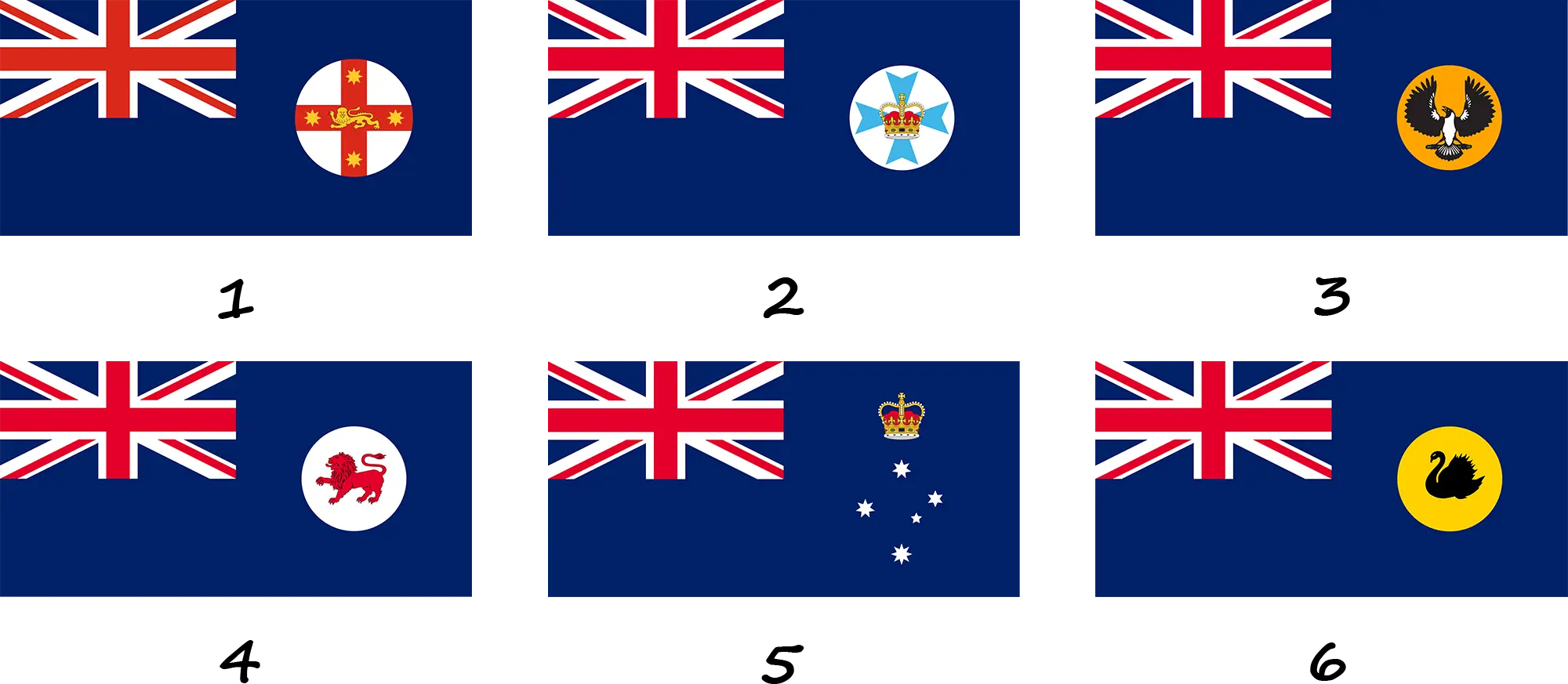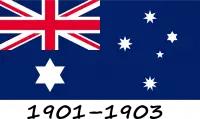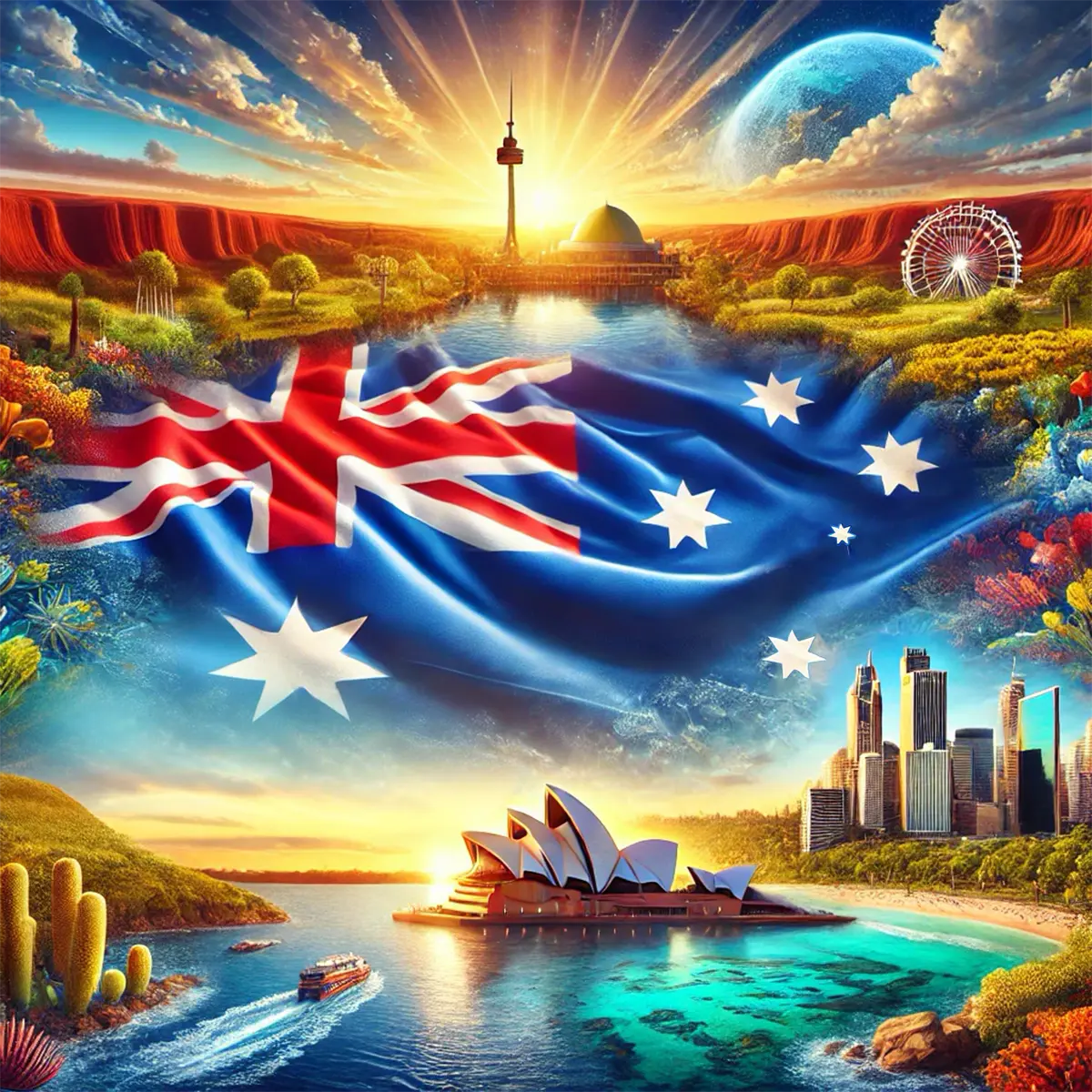Australia consists of 6 states: New South Wales (1), Queensland (2), South Australia (3), Tasmania (4), Victoria (5), Western Australia (6).

Adopted in 1876, the flag of New South Wales (1) consists of a blue cloth with the British Union Jack in the upper left corner. The flag features a red St. George's cross inside a white circle. At each end of the cross is a golden eight-pointed star, symbolizing the colony's maritime origins, namely the British navy as the defender of the state. In the center of the red cross is the image of a golden lion, known as the Lion of the South, which comes from the coat of arms of England, which consists of three similar golden lions, symbolizing strength, courage and nobility.
The flag of Queensland (2) was adopted in 1876 and consists of the Union Jack in the upper left corner and a white circle with a blue Maltese cross with a crown in the center. The Maltese cross symbolizes the connection with the Order of St. John of Jerusalem and is depicted in the form of four "V" letters or arrowheads, while the crown of St. Edward symbolizes the British monarchy and the historical origins of the state.
The flag of South Australia (3) was officially adopted on January 13, 1904 and consists of the British flag in the canton and the coat of arms, the so-called "badge" of South Australia on the right side of the flag. The badge consists of an Australian steppe eagle (Aquila audax) on a yellow background. The eagle is a symbol of freedom and independence, while the yellow color symbolizes the sun and wealth.
The flag of Tasmania (4) was adopted on September 25, 1876 and, like the flags of other Australian states, is based on the British flag (Union Jack) and coat of arms. The Tasmanian emblem is a red lion on a white circle. In addition to symbolizing strength, courage, and boldness, the lion also indicates a connection with Britain, where this symbol is quite common.
The flag of the state of Victoria (5) is almost identical to the flag of Australia - it also consists of the Southern Cross constellation, which is additionally crowned with a crown, but the flag does not have a Commonwealth star. The constellation of the Southern Cross was described earlier, but the crown of St. Edward symbolizes the connection between the state of Victoria and the British monarchy. The flag was adopted in 1877.
The flag of Western Australia (6), like the flag of South Australia (3), contains the image of an animal in a yellow circle. The black swan is a large bird, a species of swan that nests in Australia. It has black plumage and a red beak and is a monogamous bird. The black swan is a symbol of Western Australia and the English city of Dawlish, where it was introduced (a species is transferred to a new region or environment where it did not previously exist). The flag was adopted in 1953.
Australia consists of six states and two main territories - the Northern Territory (1) and the Australian Capital Territory (2).

The flag of the Northern Territory (1) consists of two vertical stripes, black and ochre, with the black stripe occupying one third of the flag and the ochre stripe occupying two thirds. The black stripe depicts the constellation of the Southern Cross, and the ochre stripe depicts a local flower, the Sturt desert rose, with seven white petals around a black center. Gossypium sturtianum is a woody shrub native to Australia and the Northern Territory and is a close relative of cultivated cotton, and is also known as Darling River rose, cotton rosebush, and Australian cotton.
The flag of the Australian Capital Territory (ACT) (2) was officially adopted on March 25, 1993 and consists of two vertical stripes of blue and yellow. The blue stripe depicts the Southern Cross, and the yellow stripe is the coat of arms of Canberra, the capital of Australia. The coat of arms consists of a blue shield with a white castle, symbolizing the Parliament building, and two swans, representing the Molonglo River and Lake Burley Griffin, and symbolizing harmony and coexistence of different cultures.
History of the Australian flag
During the colonial period, Australia used the British Union Jack as its main symbol from the founding of the first colony of New South Wales in 1788 until the early twentieth century. The Union Jack remained a symbol of British sovereignty over the Australian colonies and was officially used until the formation of the Australian Federation in 1901.

In 1901, Australian Prime Minister Edmund Barton announced an international competition for the design of a flag for the new Australian Union. A total of 32,823 entries were submitted for this competition, and five almost identical designs won first place. The new Australian flag was created on the basis of these designs. The joint winners were artist Annie Dorrington, schoolboy Ivor Evans, young man Leslie Hawkins, architect Eggbert Nutall and senior officer William Stevens.

The flag was first raised over the Exhibition House in Melbourne, which was then the seat of the federal government. The stars of the Southern Cross in the original design had a different number of rays to indicate their brightness. Initially, the flag was called the Blue Flag of the Commonwealth, and later it was renamed the national flag of Australia.

In 1903, Australia received two official flags: a blue flag and a red flag for the merchant marine. However, this caused discontent among the population. In 1941, Prime Minister Robert Menzies proposed raising the blue flag as a national symbol. Subsequently, the blue flag became the national flag of Australia, and the red flag became the flag of merchant ships. However, in 1998, the law was amended to ensure that the national flag can only be changed with the consent of the people.
In addition to the blue flag, there are other official flags of Australia, such as the Australian Aboriginal flag and the Torres Strait Islander flag, which are increasingly used in official events. The Australian Aboriginal flag was officially adopted in 1971. It consists of two horizontal stripes of equal size. The upper black stripe symbolizes the Aboriginal population of Australia, and the lower red stripe represents the land and the spiritual connection of the Aborigines to it. In the center of the flag is a yellow circle symbolizing the sun, the source of life. The author of the flag is Harold Thomas, an Aboriginal artist who created it during the Aboriginal rights movement and registered it as a copyrighted work, giving him exclusive rights to use it. This became the subject of legal disputes, resulting in Australia purchasing the copyright for $20 million in 2022. This agreement allowed all Australians to use the flag freely, without the need to obtain a license or pay royalties.

The flag of the Torres Strait Islands was adopted in 1992. It consists of three stripes, two green, located above and below the central blue, which is twice as wide as they are. In the center of the flag is a white five-pointed star, each ray of which symbolizes one of the five island groups: eastern, western, central, northern, and southern. Around the star is a white dhari, the traditional headdress of all islanders.
The modern flag of Australia was adopted in 1908 and differs from the previous version of 1903-1908 only in the number of rays of the Commonwealth star. It currently has 7 rays, while the previous version had 6.











